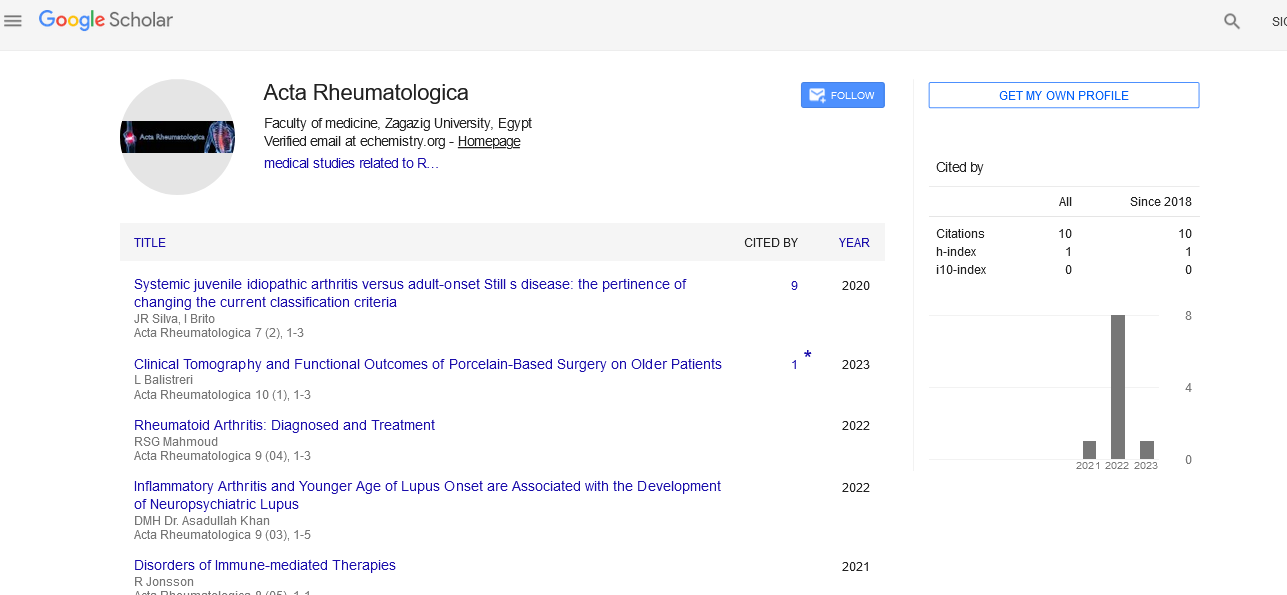Perspective - (2023) Volume 10, Issue 5
A comprehensive guide to pain relief: Understanding, managing, and living comfortably
Thiago Azario de Holanda*
Department of Paediatric Rheumatology, Canadian Universities, Brazil
*Correspondence:
Thiago Azario de Holanda, Department of Paediatric Rheumatology, Canadian Universities,
Brazil,
Email:
Received: 08-Sep-2023, Manuscript No. ipar-23-14252;
Editor assigned: 11-Sep-2023, Pre QC No. ipar-23-14252 (PQ);
Reviewed: 26-Sep-2023, QC No. ipar-23-14252;
Revised: 04-Oct-2023, Manuscript No. ipar-23-14252 (R);
Published:
12-Oct-2023
Introduction
Pain is a universal human experience. Whether acute or
chronic, it affects millions worldwide, impacting physical,
emotional, and mental well-being. Effective pain relief not
only enhances quality of life but is pivotal for overall
health. This article aims to explore the complexities of
pain, various methods of pain relief, and strategies for
living comfortably with both acute and chronic pain.
Understanding pain: Types, causes, and effects
Pain can be classified into two primary categories: acute
and chronic. Acute pain typically results from an injury or
surgery and serves as a warning sign for the body. Chronic
pain, lasting longer than three months, can result from
various conditions like arthritis, nerve damage, or
fibromyalgia. It often becomes a condition in itself,
influencing daily life and mental health.
The causes of pain are diverse and can stem from physical
trauma, inflammation, nerve damage, or underlying
health conditions. It affects people differently, impacting
mood, sleep, mobility, and overall quality of life.
Description
Methods of pain relief
Medications: Over-The-Counter (OTC) pain relievers
like acetaminophen or Nonsteroidal Anti-Inflammatory
Drugs (NSAIDs) can alleviate mild to moderate pain.
Stronger prescription medications, including opioids, are
prescribed for severe pain, but their use requires caution
due to the risk of addiction and side effects.
Physical therapy and exercise: Physical therapy and
targeted exercises can help reduce pain and improve
mobility for various conditions, including back pain,
arthritis, and injury rehabilitation.
Alternative therapies: Techniques such as acupuncture,
massage therapy, chiropractic care, and yoga offer non-invasive
approaches to pain relief and are often sought by
individuals seeking complementary or alternative methods.
Heat and cold therapy: Applying heat or cold to affected
areas can provide relief for muscle spasms, arthritis, and other localized pains. Heat can improve blood circulation,
while cold helps reduce inflammation.
Mind-body practices: Mindfulness, meditation, and
relaxation techniques aid in managing pain by reducing
stress and improving the body's response to discomfort.
Living comfortably with chronic pain
Chronic pain can significantly impact daily life. Lifestyle
modifications and coping strategies play a crucial role in
managing chronic pain effectively.
Healthy lifestyle: Maintaining a balanced diet, regular
exercise, adequate sleep, and avoiding habits like smoking
and excessive alcohol consumption can help manage chronic
pain.
Support networks: Engaging with support groups, friends,
and family helps individuals cope with the emotional and
mental toll of chronic pain.
Pain management programs: These programs offer a
structured approach to managing chronic pain, combining
medication, physical therapy, psychological support, and
education.
Adaptive tools and techniques: Using assistive devices,
ergonomic furniture, and learning adaptive techniques can
ease the strain on the body and reduce pain.
The role of healthcare providers and
research
Healthcare professionals, including primary care physicians,
pain specialists, and multidisciplinary teams, play a pivotal
role in guiding pain relief strategies. Ongoing research
focuses on understanding pain mechanisms, developing new
medications, and innovative therapies for effective pain
management.
Adverse effect
There are many sorts of agony the executives. Each have
their own advantages, downsides, and limits. A typical test
in torment the board is correspondence between the
medical services supplier and the individual encountering
pain. Individuals encountering agony might expverience
issues perceiving or depicting what they feel and how
serious it is. Medical care suppliers and patients might
experience issues speaking with one another about how
torment answers treatments. There is a gamble in many
kinds of agony the executives for the patient to take
therapy that is less successful than required or which
causes different challenges and side effects. A few
therapies for agony can be destructive if overused. An
objective of torment the executives for the patient and
their medical care supplier is to recognize how much
therapy expected to address the aggravation without going
past that limit. One more issue with torment the board is
that aggravation is the body's regular approach to
imparting a problem. Agony should determine as the
body mends itself with time and torment management.
Once in a while torment the executives covers an issue,
and the patient may be less mindful that they need
treatment for a more profound issue.
Conclusion
Pain relief is a multi-faceted journey that requires a
personalized approach. Understanding the types, causes,
and relief methods for pain is essential for individuals
seeking comfort and improved quality of life. With a
comprehensive approach involving medication, therapies,
lifestyle modifications, and support, individuals can
navigate pain more effectively, enhancing their overall
well-being. Ongoing research and advancements continue
to shape the landscape of pain relief, offering hope for
better outcomes and improved strategies for living
comfortably with pain.





